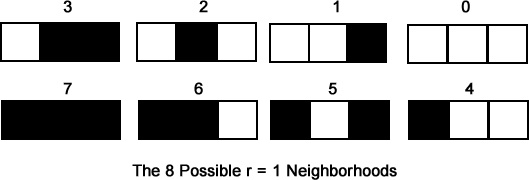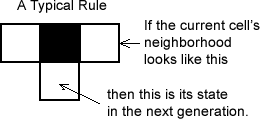Since each cell has three neighbors, and each of these three cells can have two states, there are 2.2.2 = 23 = 8 different neighborhoods. They are:


| The rule to the right says: "If the current cell is black (on/alive) and both of its neighbors are white (off/dead), then the current cell becomes white in the next generation. |  |
|---|
A rule for generating an elementary cellular automaton is shown above. In words, this rule says, "If there are exactly two 'on' cells in the neighborhood, make the next generation an 'on' cell, otherwise make it an 'off' cell." In the eight possible neighborhoods, the active (current) cell is in the middle, and its neighbors are to its left and right. Below each neighborhood is a single cell, either on or off (black or white). The idea is to find the neigborhood that matches the neighborhood of the current cell, and then update the current cell in the next generation with the cell below the neighborhood. Actually, it is easier done than said.
Since there are eight possible neighborhoods, and each one produces an on/off value for the next generation, there must be 2.2.2.2.2.2.2.2 = 28 = 256 possible rules for elementary cellular automata. Stephen Wolfram (physicist, mathematician, MacArthur (Genius) Grant winner, CA researcher, originator of Mathematica, etc.) realized that if you treat "on" as "1" and "off" as "0", that every rule could be represented by an 8-bit binary number. The binary number corresponding to the rule shown above would be "01101000". This binary number can be translated into a base-10 number by adding the place values of the "on" digits (shown below the diagrams above). The CA "00000000" = 0, which says "turn all the cells in the next generation "off" is the lowest-numbered CA (Rule 0). The CA "11111111" = 255, which says "turn all the cells in the next generation "on", is the highest-numbered CA (Rule 255). (Neither of these CA's turn out to be very interesting.) The rule number for the rule shown above is 64 + 32 + 8 = 104. The CA generated by this rule is the "Rule 104" CA.(Actually, the Rule 104 isn't very exciting either - but some are!)
last update November 21, 2009 by JL Stanbrough